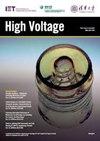用超高频技术定位电力变压器局部放电
IF 4.9
2区 工程技术
Q1 ENGINEERING, ELECTRICAL & ELECTRONIC
引用次数: 0
摘要
本文讨论了利用超高频(UHF)测量方法确定电力变压器局部放电位置的方法。超高频技术利用最短路径法和双曲线法两种方法来寻找局部点的位置。最短路径法的工作原理是将实测数据与数据库中的数据进行比较。在双曲型方法中,每个传感器的两个单元子集之间得到一个双曲方程。最适合所有方程的坐标称为PD位置,可以通过三种不同的方法获得,即迭代算法、Fang方法和Chan方法。迭代算法的收敛性受到初始估计差、超调、不收敛性缓解等问题的限制。Fang法和Chan法是通信系统中用于寻找辐射源位置的两种封闭解。本文阐述了如何利用这两种方法获得电力变压器内部的局部放电坐标。这两种方法可以精确地找到最适合所有双曲方程的坐标。在本文的最后,通过CST软件进行了几次测试,并通过所有提出的方法估计了PD位置。仿真结果表明,Fang和Chan方法克服了迭代法的局限性。本文章由计算机程序翻译,如有差异,请以英文原文为准。
Partial Discharge Localisation in Power Transformer by UHF Technique
This article deals with the methods of finding partial discharge (PD) location in power transformers using ultra high frequency (UHF) measurements. The UHF technique utilises two methods to find the PD location, that is, the shortest path method and hyperbolic method. The shortest path method works based on the comparison of the measured data and the ones in the database. In the hyperbolic method, a hyperbolic equation is obtained between each two element subset of sensors. The coordinate that best fits all equations is known as the PD location, and can be obtained in three different ways, that is, iterative algorithms, the Fang method and Chan method. The convergence of iterative algorithms is limited by poor initial estimate, overshoot, mitigation of non-convergence etc. The Fang and Chan methods are two closed-form solutions that are used in the communication system to find the radiation source location. This article explains how to use these two methods to obtain the PD coordinate inside the power transformer. These two methods can find exactly the coordinate that best fits all hyperbolic equations. At the end of this article, several tests are carried out through CST software and the PD locations is estimated by all presented methods. The simulation results show how the Fang and Chan methods can overcome the limitations of the iterative method.
求助全文
通过发布文献求助,成功后即可免费获取论文全文。
去求助
来源期刊

High Voltage
Energy-Energy Engineering and Power Technology
CiteScore
9.60
自引率
27.30%
发文量
97
审稿时长
21 weeks
期刊介绍:
High Voltage aims to attract original research papers and review articles. The scope covers high-voltage power engineering and high voltage applications, including experimental, computational (including simulation and modelling) and theoretical studies, which include:
Electrical Insulation
● Outdoor, indoor, solid, liquid and gas insulation
● Transient voltages and overvoltage protection
● Nano-dielectrics and new insulation materials
● Condition monitoring and maintenance
Discharge and plasmas, pulsed power
● Electrical discharge, plasma generation and applications
● Interactions of plasma with surfaces
● Pulsed power science and technology
High-field effects
● Computation, measurements of Intensive Electromagnetic Field
● Electromagnetic compatibility
● Biomedical effects
● Environmental effects and protection
High Voltage Engineering
● Design problems, testing and measuring techniques
● Equipment development and asset management
● Smart Grid, live line working
● AC/DC power electronics
● UHV power transmission
Special Issues. Call for papers:
Interface Charging Phenomena for Dielectric Materials - https://digital-library.theiet.org/files/HVE_CFP_ICP.pdf
Emerging Materials For High Voltage Applications - https://digital-library.theiet.org/files/HVE_CFP_EMHVA.pdf
 求助内容:
求助内容: 应助结果提醒方式:
应助结果提醒方式:


